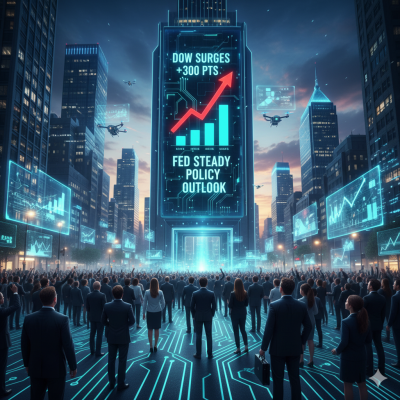Dow Surges 300 Points as Investors Cheer Fed’s Steady Policy Outlook
Introduction
On October 7, 2025, Wall Street opened the week with renewed vigor as the Dow Jones Industrial Average surged 300 points to close at 37,890. This rally marked a decisive shift in investor sentiment, fueled largely by the Federal Reserve’s latest meeting minutes, which indicated no immediate plans to raise interest rates. Market participants interpreted this stance as a signal of policy stability, encouraging risk-taking and renewed investment in equities. Following several weeks of volatility caused by inflation concerns and global economic uncertainties, traders were eager for reassurance, and the Fed delivered precisely that. Broad-based gains were observed across the S&P 500, which rose by 0.8%, and the Nasdaq Composite, up 1.1%, highlighting the widespread optimism in both traditional and tech-heavy sectors.
Market Context
The rally reflected a complex interplay between macroeconomic indicators, corporate earnings reports, and investor psychology. Technology stocks, in particular, led the charge, with giants like Microsoft, Apple, and Nvidia posting significant gains. Microsoft rose 2.3% following strong guidance on AI-driven enterprise solutions, while Nvidia climbed 3% as analysts adjusted earnings expectations in response to robust demand for GPU products. Consumer discretionary stocks, including Nike and Starbucks, also benefited from the Fed’s accommodative stance, as lower interest rate expectations typically stimulate consumer spending. Meanwhile, industrial and financial sectors saw moderate gains, with Boeing climbing 2.2% after reporting strong backlogs for commercial aircraft orders, and JPMorgan rising 1.5% amid stable lending forecasts.
Commodity markets exhibited a stabilizing trend alongside equities. Oil prices remained steady at $91 per barrel, balancing geopolitical supply concerns and robust global demand. Gold futures inched higher to $2,050 per ounce, reflecting a traditional flight-to-safety amid lingering market uncertainties. The bond market, however, displayed some caution, with 10-year U.S. Treasury yields hovering near 4.9%, signaling that while equity investors were optimistic, fixed-income markets remained sensitive to macroeconomic data and inflation expectations.
Policy Update
The Federal Reserve’s meeting minutes provided critical clarity for market participants. Policymakers highlighted their commitment to closely monitoring inflation trends, labor market dynamics, and consumer spending patterns before taking any action. While inflation remains slightly above the 2% target, the Fed emphasized that it has shown signs of moderation, allowing a data-driven, cautious approach. Analysts viewed the absence of immediate rate hikes as a strategic move to sustain economic growth while maintaining price stability.
The Fed also signaled that liquidity conditions will be maintained, ensuring that financial institutions have sufficient access to capital and credit. This reassurance was particularly important for sectors reliant on borrowing and investment, including real estate, manufacturing, and technology. Investors responded by reallocating funds into equities, especially those expected to benefit from continued corporate investment and consumer confidence.
Analyst Insight
Market strategists lauded the Fed’s transparent communication as a stabilizing factor. Laura Chen, senior equities strategist at MarketWatch, remarked, “The Fed’s cautious approach provides a conducive environment for equities to thrive. Investors are responding to stability and predictability, which has been missing in previous weeks.” Similarly, John Peters, a Bloomberg market analyst, noted that the rally was “not just about the Fed; it’s about renewed confidence in corporate fundamentals and the resilience of the U.S. economy.”
Analysts also emphasized that while the Dow’s gains are encouraging, investors should remain vigilant. Upcoming economic indicators, including the nonfarm payroll report and Q4 corporate earnings, could introduce volatility if the data diverges from expectations. Despite these potential headwinds, the market’s current trajectory suggests a period of measured optimism, with sectors tied to technology, energy, and consumer spending likely to outperform.
Future Outlook
Looking ahead, equity markets are poised to maintain momentum if key economic indicators continue to show stability. Analysts anticipate that sectors such as technology and consumer discretionary will remain at the forefront of the rally, supported by strong earnings and favorable monetary conditions. Industrial stocks may see further gains as infrastructure spending remains robust and energy firms benefit from stable oil prices.
Geopolitical events and global trade developments will continue to influence sentiment, but the Fed’s measured approach provides a buffer against sudden shocks. Investors are advised to maintain diversified portfolios, balancing high-growth equities with defensive sectors and safe-haven assets like gold. Moreover, market participants should monitor bond yields, as shifts in fixed-income markets could affect liquidity and equity valuations.
Conclusion
The Dow’s 300-point surge underscores the market’s positive response to the Federal Reserve’s steady policy outlook. By signaling no immediate rate hikes and maintaining transparency on economic conditions, the Fed has restored confidence among investors, prompting broad-based gains across multiple sectors. While challenges remain in the form of global uncertainties and potential economic surprises, the underlying strength of corporate earnings and consumer activity provides a solid foundation for continued growth. As markets evolve, investors who stay informed and adopt a disciplined, data-driven approach will be best positioned to capitalize on opportunities while mitigating risks in this dynamic financial landscape.




